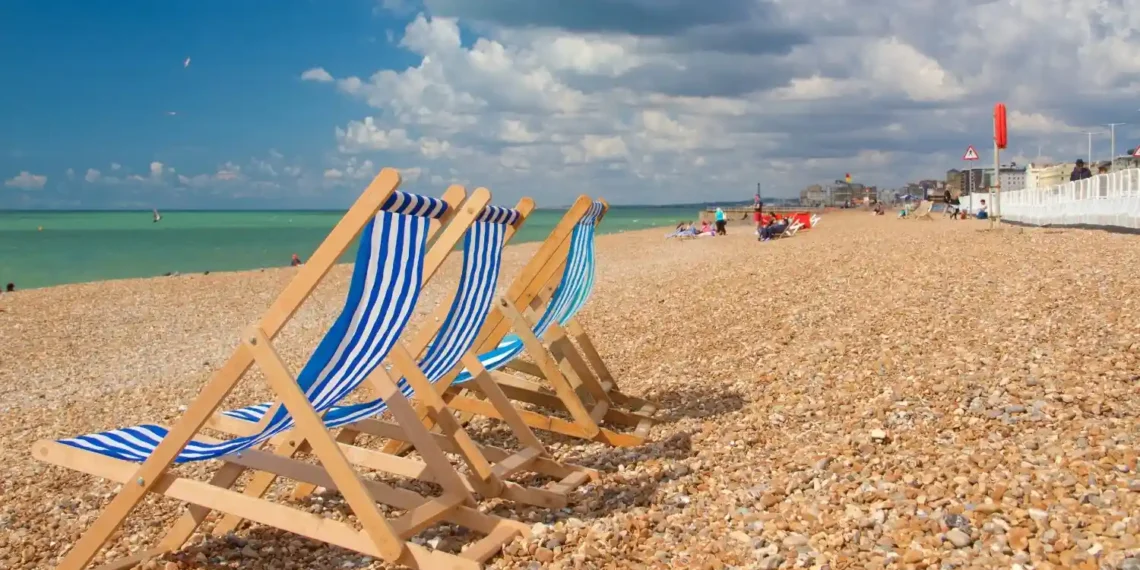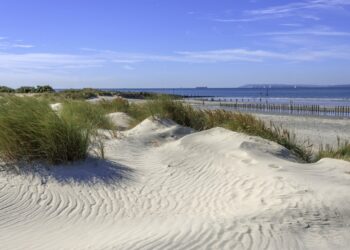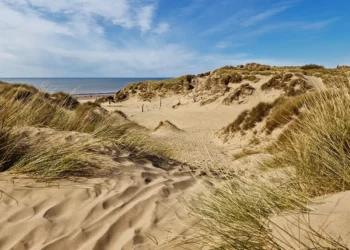Brighton Beach, sitting on the south coast of England, in East Sussex, is one of the UK’s most visited seaside places. Known for its lively atmosphere, historic charm, and pebbled shoreline, it draws millions of visitors every year. Right in Brighton city, the beach mixes history, things to do, and nice views. Here we take a simple look at Brighton Beach, its history, what you can see and do, and some tips if you want to visit.
Fun Fact About Brighton Beach
Unlike many other beaches, Brighton’s shore is covered with pebbles rather than sand. These smooth, colorful pebbles have been worn down by the sea over many years, giving the beach its unique appearance.
History of Brighton Beach
Brighton Beach grew as the town of Brighton grew. Long ago, it was just a small fishing village called Brighthelmstone. In the early 1700s, fishing was the main activity, and the beach was used by locals to launch their boats and mend nets.
Things started changing around the mid-18th century when a doctor named Richard Russell wrote about how seawater, bathing in it and drinking it, could be good for health. His 1750 book made wealthy people interested in coming to Brighton. By the 1780s, the Prince of Wales, later King George IV, visited Brighton. When he started coming, Brighton became quite fashionable, and that’s when the Royal Pavilion, a big fancy palace, was built, it still stands there today as part of the town’s old history.
By 1841, the railway finally reached Brighton, so it was much easier for people from London to come. After that, the beach turned into a place where people went just to relax and have some fun. Quite a few Bathing machines, wooden carts that allowed visitors to change clothes in private before going into the water, were commonly seen along the shore. The West Pier opened in 1866, and the Palace Pier, now called Brighton Pier, opened in 1899, giving people more entertainment and nice views of the sea.
In the 20th century, Brighton Beach became a place for artists and musicians, especially in the 1960s and 1970s. Even though the West Pier was damaged by storms and fires, it closed in 1975 and was mostly destroyed by 2003, the beach still keeps its old charm while also being lively and modern.
Things to Do at Brighton Beach
Brighton Beach has plenty to do for different kinds of visitors, from relaxing walks to cultural sightseeing. Here are some highlights:
Brighton Pier: Also called Brighton Palace Pier, this is a must-see spot. Stretching 1,722 feet, it has lots of amusement rides, arcades, and food stalls serving classic fish and chips. The pier’s observation tower, the Brighton i360, rises 450 feet and gives wide views of the coastline and South Downs.
Pebble Beach Walks: The pebbled shore allows visitors to have relaxing walk while hearing the waves. It’s also quite great for photos, especially at sunset when the sky glows over the water.
Water Sports: New Brighton Beach offers paddleboarding, kayaking, and windsurfing. For those seeking more excitement, jet skiing and powerboat rides are offered during the summer months. Swimming is allowed in certain areas, and lifeguards watch over them during busy times.
Cultural Visits: Near the beach is Brighton’s cultural area, called the Lanes, narrow streets filled with little shops, cafes, and art galleries. The Brighton Museum and Art Gallery nearby shows local history and art. The Royal Pavilion, with its Indo-Saracenic style, is in fact, open for guided tours exploring its royal past.
Events and Festivals: The Brighton Fringe in May includes theater, comedy, and street performances. The Brighton Festival, also in May, features music, dance, and visual arts. During summer, quite a few open-air concerts and food festivals take place frequently along the beach.
Food and Nightlife: The beachfront has many restaurants and bars, serving seafood and international dishes. The historic Regency Restaurant is known for its fresh fish. Nightlife includes clubs like Shooshh and The Arch, where DJs play live music with sea views.
Relaxation and Wellness: For quiet time, visitors can rent deckchairs or join yoga sessions on the beach in summer. Brighton Marina nearby has spas and Brighton beach saunas for those who want some extra care for them after a day by the sea. Brighton beach houses are also famous.
Best Time to Visit Brighton Beach
April to June
Spring in Brighton is generally mild, around 10°C to 15°C, with longer days, good for walking along the beach and checking out nearby spots. There are fewer people than in summer, and hotels are usually cheaper. May hosts the Brighton Festival and Brighton Fringe, bringing music, art, and theater to the seafront.
July to August
Summer is the busiest time, considered best Brighton each weather with temperatures about 18°C to 22°C. The beach becomes busy, quite ideal for swimming, water activities, and visiting Brighton Pier. Crowds are bigger and prices higher, so it’s better to book stays in advance.
September to November
Autumn is quieter, with cooler weather around 10°C to 16°C and fewer visitors, making it nice for relaxed walks and photography.Early in the season, the sea is still warm enough for a swim, and the South Downs’ colors make walks scenic. Rain increases later in autumn but usually comes in short showers, leaving time for outdoor activities.
December to March
Winter is cooler (3°C to 8°C) and peaceful, ideal if you want a calm visit. The seafront looks serene, and indoor attractions like the Royal Pavilion and Brighton Museum are great for rainy days. Winter events, like Christmas lights and ice skating near the Pavilion, add a festive touch, though some beachfront places may have shorter hours.










